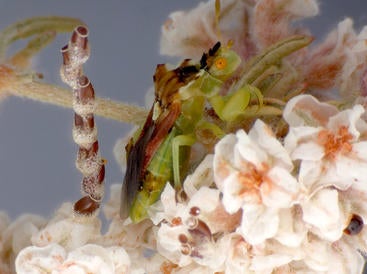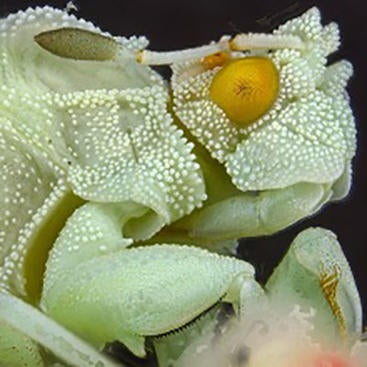Diagnosis and Specialized Morphology
Commonly called ambush bugs, Phymatinae are a group of morphologically distinct assassin bugs. Most members of the group are characterized by:
- conspicuously enlarged fore femur
- forewing membrane often without distinct cells, or if with cells, with several supernumerary veins radiating from them posteriorly
- usually clubbed antennae
Taxonomic History
Phymatinae have been considered as a distinct family within Cimicomorpha (Froeschner & Kormilev 1989, Maldonado 1990), and the name Phymatidae is still being used in some current literature and popular websites (e.g. whatsthatbug.com, bugguide.net). Carayon et al. (1958) were the first to reduce Phymatidae to a subfamily within Reduviidae, based on shared derived characters. In a recent cladistic analysis (Weirauch 2008), the placement of Phymatinae as a member of the subfamilies of Reduviidae was confirmed. Therefore, the name Phymatidae should no longer be used. There are a few monographs on Phymatinae, namely Handlirsch (1897), Kormilev (1962) and Maa & Lin (1956).
Four tribes are currently recognized: Carcinocorini, Macrocephalini, Phymatini, and Themonocorini (Carayon et al. 1958). Froeschner & Kormilev (1989) provided a catalogue of Phymatinae and recorded 281 species and 26 genera. Since then, two new genera (Kormilev & van Doesburg 1991, van Doesburg 1997, 2004) and numerous new species and one new subspecies have been described (Kormilev 1990 a, b, c, Kormilev & van Doesburg 1991, 1992, Cui et al. 2003, Rabitsch 2003, Rabitsch et al. 2006, van Doesburg 2004, van Doesburg & Pluot-Sigwalt 2007, van Doesburg & Jacobs 2011). Hence, there are currently 303 taxa and 28 genera in the subfamily Phymatinae.
Natural History/Biology
Little is known about the biology of the members of Phymatinae other than some common species of the genus Phymata. As the common name, ambush bugs, suggests, the Phymatinae are predatory, usually hide among flowers, and mount a sudden attack on their prey. They are generalist predators, and feed on a variety of small arthropods. Interestingly, the species Phymata pennsylvanica Handlirsch has been observed to feed on nectar (Yong 2003). The author suggested that nectar-feeding could allow the bug to survive longer when preys are scarce. However, it would not be sufficient for normal growth or development, and experiment confirmed that juveniles feeding exclusively on sucrose were not able to molt. Another interesting case is that the adults and nymphs of the African Themonocoris kinkalanus, with comparatively less modified front legs were observed to actively seek their prey in nests of the weaver bird genus Ploceus Cuvier, in flower and fruit clusters of the palm genus Elaeis Jacquin, and in masses of dead plant matter (Carayon et al. 1958).
Other observations of biology of Phymatinae include pre- and postcopulatory mating guarding behavior in Phymata fasciata (Gray) (Dodson & Marshall, 1984) and production of acoustical signals in Phymata crassipes (Fabricius) (Gogala & Cokl 1983).
A list of new species and two new genera since 1989
New genera:
Kormilevida van Doesburg 1997 (= Phymatocoris Kormilev & van Doesburg 1991, praeocc.)
Goellneriana van Doesburg 2004
New species:
|
Species |
Author |
Locality |
|---|---|---|
|
Agdistocoris kormilevi |
Cui et al. 2003 |
Hainan, China |
|
Carcinocoris yunnanus |
Rabitsch et al. 2006 |
Yunnan, China |
|
Chelocoris heissi |
Rabitsch et al. 2006 |
Yunnan, China |
|
Glossopelta laotica |
Rabitsch 2004 |
Laos |
|
Goellneriana deckerti |
van Doesburg 2004 |
Namibia |
|
Kormilevida iviei |
Kormilev & van Doesburg 1991 |
Dominican Republic |
|
Lophoscutus hispaniolensis |
Kormilev & van Doesburg 1991 |
Dominican Republic |
|
Lophoscutus pugil |
Kormilev & van Doesburg 1992 |
Mexico |
|
Oxythyreus slateri |
van Doesburg & Pluot-Sigwalt 2007 |
South Africa |
|
Oxythyreus cylindricornis schuhi |
van Doesburg & Pluot-Sigwalt 2007 |
South Africa |
|
Themonocoris endroedyi |
van Doesburg & Jacobs 2011 |
South Africa |
References
Carayon, J., Usinger, R.L., Wygodzinsky, P. 1958. Notes on the higher classification of the Reduviidae, with the description of a new tribe of the Phymatinae (Hemiptera-Heteroptera). Revue de Zoology and Botanique africaine 57: 256-281.
Cui, J., Cai, W., Rabitsch, W. 2003. Notes on the genus Agdistocoris Kormilev, 1962 (Heteroptera: Reduviidae: Phymatinae), with the description of a new species from China. Annales Zoologici (Warszawa) 53: 669-671.
Dodson, G., Marshall, L. 1984. Mating Patterns in an Ambush Bug Phymata fasciata (Phymatidae) American Midland Naturalist 112: 50-57
Handlirsch, A. 1897. Monographic der Phymatiden. Ann. Kaiserlich-königlichen Naturhist. Ges. Holfmuseum 12:127-230.
Gogala, M., Cokl, A. 1983. The acoustical behavior of the bug Phymata crassipes (F.) (Heteroptera. Revue Canadienne de Biologie Experimentale 42: 249-256.
Kormilev, N.A. 1990a. Notes on American Phymatidae, with description of a new species of Phymata Latreille. Anales del Instituto de Biologia Universidad Nacional Autonoma de Mexico Serie Zoologia 61: 99-106.
Kormilev, N.A. 1990b. Two new species of the genus Lophoscutus Kormilev, 1951 (Hemiptera, Phymatidae). Revista Brasileira de Entomologia 34: 221-225.
Kormilev, N.A. 1990c. A new species of the genus Chelocoris from Vietnam (Hemiptera: Phymatidae: Carcinocorinae). Bishop Museum Occasional Papers 30: 298-300.
Kormilev, N.A., van Doesburg, P.H. 1991. Notes on Caribbean Phymatidae (Hemiptera: Heteroptera). Zoologische Mededelingen (Leiden) 65: 277-285.
Kormilev, N.A., van Doesburg, P.H. 1992. Notes on Macrocephalinae (Heteroptera: Phymatidae). Zoologische Mededelingen (Leiden) 66: 417-421.
Maa T.C., Lin, K.S. 1959. Further notes on Old World Phymatinae (Hemiptera: Reduviidae). Pacific Insects 1: 315-323.
Rabitsch, W. 2004. Glossopelta laotica sp. n. (Insecta: Heteroptera: Reduviidae: Phymatinae), a new ambush bug from Laos. Annalen des Naturhistorischen Museums in Wien Serie B Botanik und Zoologie 105B: 447-451.
Rabitsch, W., Cui, J., Cai, W. 2006. Two new ambush bugs from Yunnan, southern China (Insecta, Heteroptera, Reduviidae, Phymatinae). Denisia 19: 581-588.
Schuh, R.T., Slater, J.A. 1995. True Bugs of the World (Hemiptera: Heteroptera): Classification and Natural History. Comstock Pub. Associates, Ithaca. 336 pp.
Usinger, R.L., Wygodzinsky, P. 1964. Description of a new species of Mandanocoris Miller, with notes on the systematic position of the genus (Reduviidae, Hemiptera, Insect). Am. Mus. Novit. 2204: 13 pp.
van Doesburg, P.H. 2004. Goellneriana deckerti gen. nov. & spec. nov. (Heteroptera: Reduviidae: Phymatinae: Macrocephalini) from Namibia, with a review of the Afrotropical ambush bugs. Zoologische Mededelingen (Leiden) 78: 147-159.
van Doesburg, P.H. 1997. A case of homonomy in the Phymatidae (Heteroptera). Ent. Ber., Amst. 57: 96.
van Doesburg, P.H., Pluot-Sigwalt, D. 2007. Notes on Phymatinae (Insecta: Heteroptera: Reduviidae). The genus Oxythyreus Westwood, 1841. Zoologische Mededelingen (Leiden) 81: 85-99.
van Doesburg, P. H., & Jacobs, D. H. 2011. A new Themonocoris from South Africa (Hemiptera: Heteroptera: Reduviidae: Phymatinae: Themonocorini). Zoologische Mededelingen, 85(1), 55-67.
Yong, T.H. 2003. Nectar-feeding by a predatory ambush bug (Heteroptera: Phymatidae) that hunts on flowers. Ann. Entomol. Soc. Am. 96: 643-651.
*Contributed by Guanyang Zhang and Wolfgang Rabitsch [http://homepage.univie.ac.at/wolfgang.rabitsch


